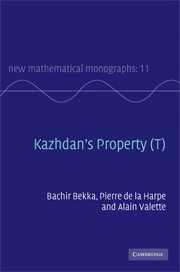Book contents
- Frontmatter
- Contents
- List of figures
- List of symbols
- Introduction
- PART I KAZHDAN'S PROPERTY (T)
- PART II BACKGROUND ON UNITARY REPRESENTATIONS
- A Unitary group representations
- B Measures on homogeneous spaces
- C Functions of positive type and GNS construction
- D Unitary Representations of locally compact abelian groups
- E Induced representations
- F Weak containment and Fell's topology
- G Amenability
- Bibliography
- Index
D - Unitary Representations of locally compact abelian groups
Published online by Cambridge University Press: 12 September 2009
- Frontmatter
- Contents
- List of figures
- List of symbols
- Introduction
- PART I KAZHDAN'S PROPERTY (T)
- PART II BACKGROUND ON UNITARY REPRESENTATIONS
- A Unitary group representations
- B Measures on homogeneous spaces
- C Functions of positive type and GNS construction
- D Unitary Representations of locally compact abelian groups
- E Induced representations
- F Weak containment and Fell's topology
- G Amenability
- Bibliography
- Index
Summary
Classical harmonic analysis rests on a few general and powerful theorems concerning the Fourier transform. These are Plancherel's Theorem on L2-functions and Pontrjagin's Duality, recalled without proofs in Section D.1 (overall references are [Bou–Spec] and [Folla–95]), and Bochner's Theorem on Fourier transforms of positive measures, stated and proved here in Section D.2.
It was Hermann Weyl who realised around 1925 that classical harmonic analysis is naturally expressed in terms of unitary group representations (classically, the groups are Rn, Zn, and Tn = Rn/Zn). Then Stone described in 1930 all unitary representations of the additive group R; the generalisation to arbitrary locally compact abelian groups is due independently to Naimark, Ambrose, and Godement, and is the so-called SNAG Theorem of Section D.3.
The SNAG Theorem, concerning abelian groups, is necessary in Chapter 1 for our analysis of the unitary representations of groups like SLn(K), where K is a local field. We recall in Section D.4 a few facts about local fields.
In Sections D.1–D.3, we denote by G a locally compact abelian group, with fixed Haar measure dx. The dual group of G (see Section A.2) is contained in the set of normalised functions of positive type (see Section C.5). More precisely, with appropriate identifications (see Corollary A.2.3, Remark C.4.13, and Theorem C.5.2), we have. The topology of uniform convergence on compact subsets of G makes a topological group, and it is shown in Section D.1 that is locally compact.
- Type
- Chapter
- Information
- Kazhdan's Property (T) , pp. 369 - 382Publisher: Cambridge University PressPrint publication year: 2008

